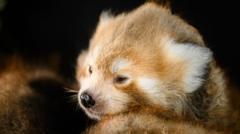Could Three Endangered Red Panda Cubs Be the Star Attraction at the Zoo?

Three endangered red panda cubs have recently been born in a zoo in south-west Wales, marking a significant step in conservation efforts for this vulnerable species. These cubs are crucial for the survival of red pandas, whose populations are continuously declining due to various threats, including habitat loss and disease. They are currently being cared for by their mother, Betty, while staff closely monitor their development.
Last updated: 29 October 2023 (BST)
Key Takeaways
- Three red panda cubs were born in a Welsh zoo, enhancing conservation efforts.
- The species is endangered, facing threats from deforestation and disease.
- Staff are monitoring the cubs' health and growth closely.
- The cubs will eventually be moved to other accredited facilities for further breeding.
- They are currently fed milk and will transition to solid food as they grow.
The Importance of the Red Panda
The red panda (Ailurus fulgens) is a small mammal native to the eastern Himalayas and southwestern China. It is distinct for its striking reddish-brown fur, bushy tail, and a generally adorable appearance that has made it a favourite in zoos worldwide. However, despite their popularity, red pandas are classified as endangered on the International Union for Conservation of Nature (IUCN) Red List, with populations declining due to several pressing threats.
Threats Facing Red Pandas
According to Kim Wilkins, head keeper at the zoo, red panda populations are under siege from:
- Deforestation: The destruction of their natural habitat for agriculture and urban development significantly reduces their living space.
- Hunting: Although hunting is less prominent than habitat loss, poaching for their beautiful fur remains a concern in some areas.
- Diseases: The spread of diseases from domestic dogs and cats poses a serious health risk to wild red panda populations.
Welcoming New Life
The recent birth of three cubs at the Welsh zoo is a beacon of hope for red panda conservation. Betty and Barney, the cubs' parents, were paired as part of the European Endangered Species Programme (EEP), which aims to maintain healthy populations of endangered species in captive environments. Ms Wilkins notes that these cubs are "crucial" for the species' survival, highlighting their significance beyond just being adorable additions to the zoo.
Development and Care of the Cubs
The cubs, now just over six weeks old, are currently under the watchful eye of zookeepers. While it's too early to determine their sex, the cubs are beginning to develop the distinctive markings characteristic of red pandas. Ms Wilkins reported that the staff are refraining from disturbing them too much at this early stage to ensure their safety and well-being.
Feeding and Growth
At this stage in their lives, the cubs are still reliant on their mother, Betty, for milk. This will continue for several weeks, after which Betty will gradually reduce nursing sessions to encourage the cubs to start eating solid food. The transition to solid food is a crucial step in their development and will help them grow stronger as they prepare for the next phase of their lives.
Future Prospects
Once they are old enough, the cubs will be transferred to other accredited facilities as part of the ongoing captive breeding programme for red pandas. This initiative is vital for ensuring genetic diversity and the long-term survival of the species. The collaborative efforts of zoos across Europe are essential in combating the threats facing red pandas and ensuring that they continue to thrive, both in captivity and in the wild.
Why This Matters
Conservation efforts for red pandas are not just about saving one species; they are indicative of broader environmental issues. The decline of red pandas often reflects the health of their habitat, which is crucial for other species as well. Protecting red pandas can lead to improved conservation strategies that benefit entire ecosystems. Furthermore, successful breeding programmes can inspire similar initiatives for other endangered species, creating a ripple effect of positive change in wildlife conservation.
Conclusion
The birth of these three red panda cubs at the Welsh zoo embodies hope and progress in the fight against species extinction. By continuing to support conservation efforts and breeding programmes, we can contribute to preserving these remarkable creatures for future generations. As their story unfolds, it serves as a reminder of our responsibility towards biodiversity and the urgent need to act to protect our planet's wildlife.
As we celebrate the arrival of these cubs, it's essential to remember that every small effort counts in the larger battle for conservation. What steps do you think can be taken to raise awareness about endangered species? #RedPandaConservation #EndangeredSpecies #Biodiversity
FAQs
What is the current status of red pandas in the wild?
Red pandas are classified as endangered, with their populations declining due to habitat loss, hunting, and diseases. Conservation efforts are critical for their survival.
How do zoos contribute to red panda conservation?
Zoos participate in breeding programmes that help maintain genetic diversity and support the eventual reintroduction of red pandas into their natural habitats.
What are the main threats to red pandas?
The primary threats to red pandas include deforestation, poaching, and diseases from domestic animals, which all contribute to their declining numbers.
How long do red panda cubs stay with their mother?
Red panda cubs typically stay with their mother for several months, relying on her for milk initially, before transitioning to solid food as they grow.
What do red pandas eat in the wild?
In the wild, red pandas primarily eat bamboo, but they may also consume fruits, acorns, and small animals when bamboo is scarce.
Published: 2025-08-21 12:55:13 | Category: wales



